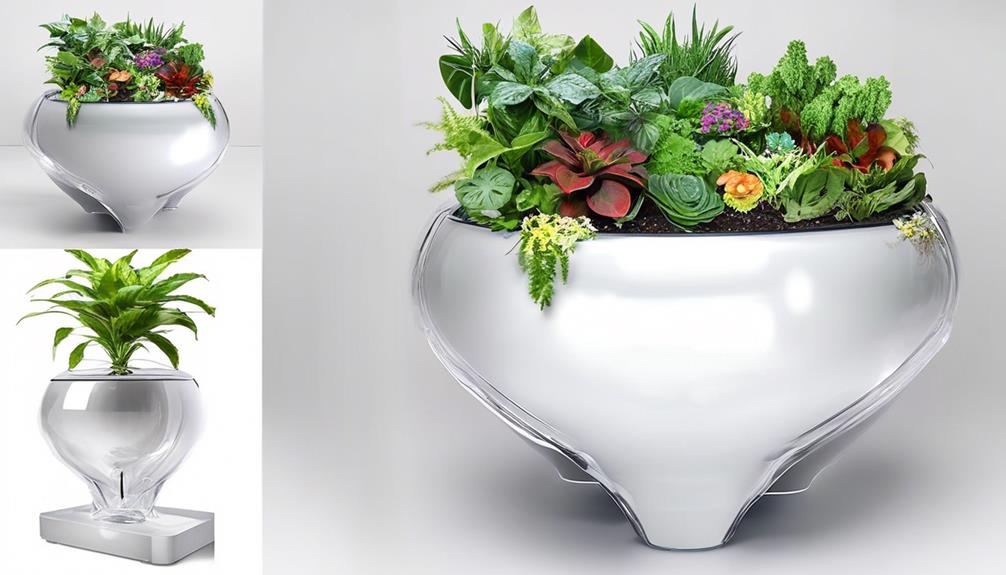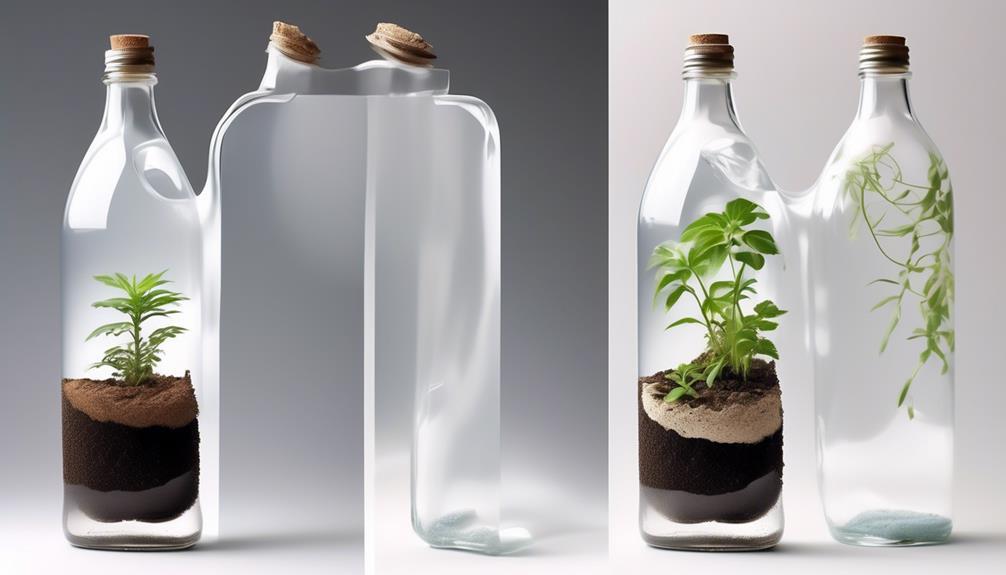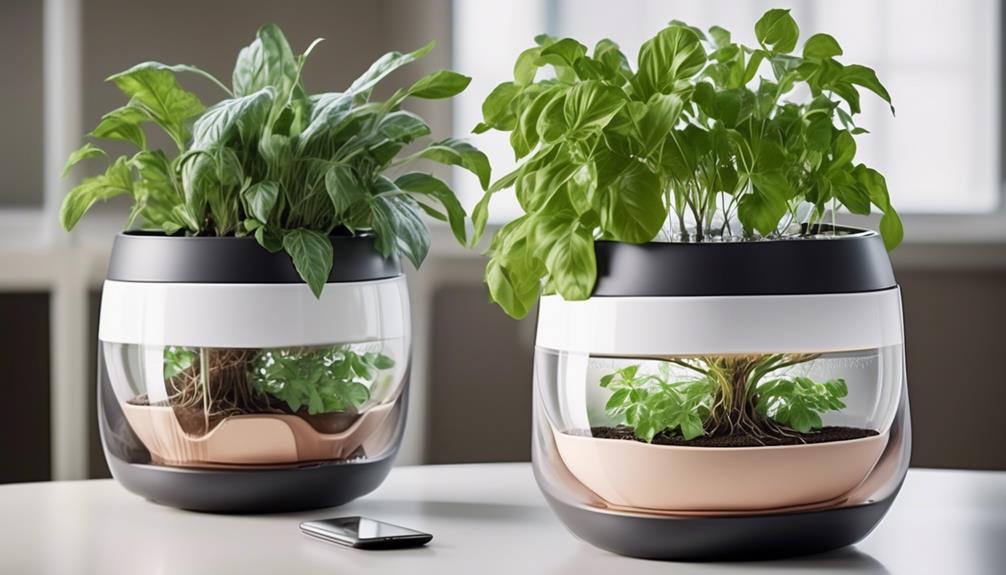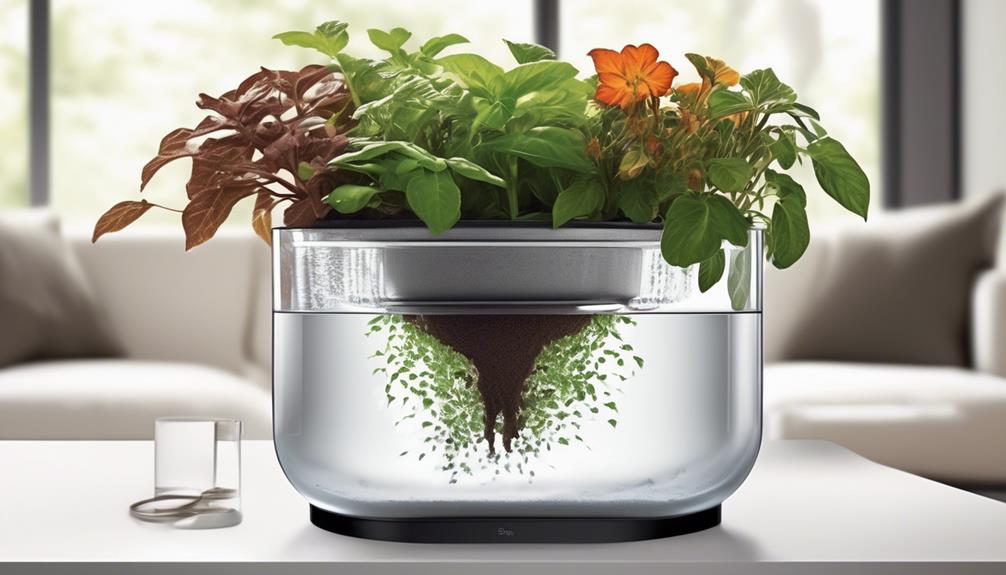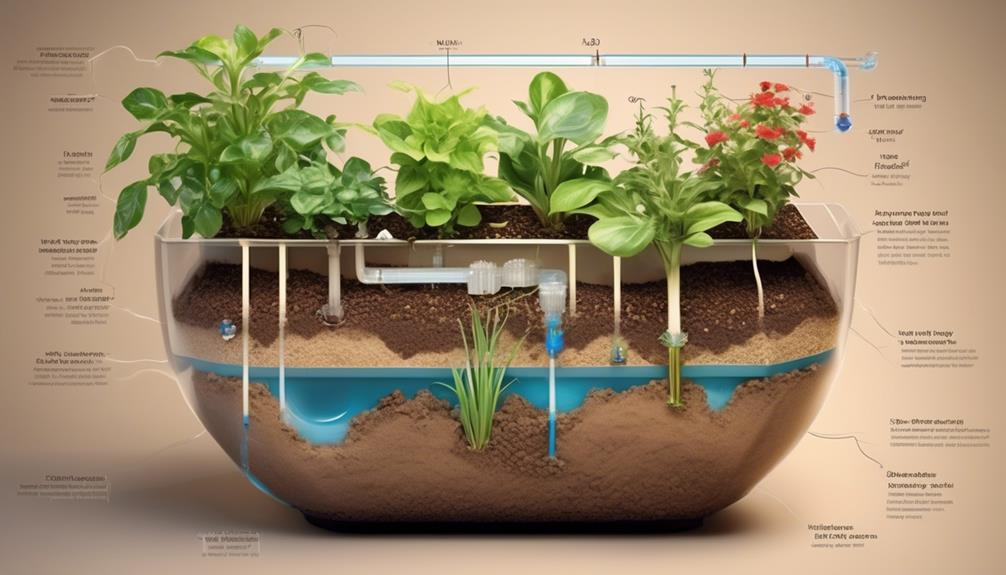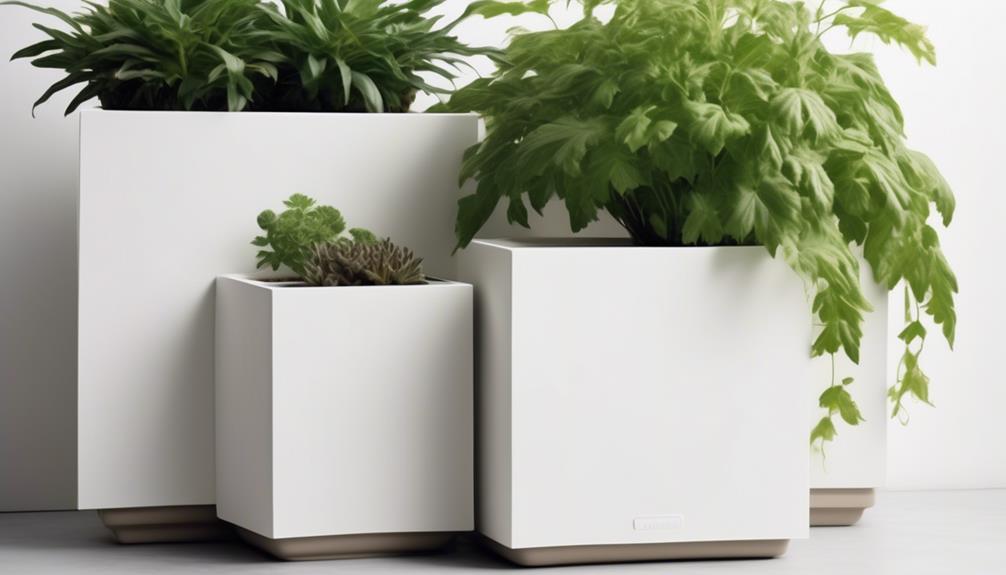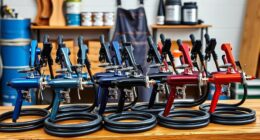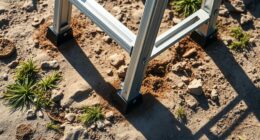Many individuals have questioned whether self-watering containers are a viable way to support plant health and growth, eliminating the need for frequent manual watering. It is important to weigh the advantages and disadvantages of self-watering systems, comparing their practicality to the needs of different plant types.
Are these innovative planters truly a game-changer in the world of gardening, or do they come with hidden downsides that might surprise even the most seasoned green thumbs?
Key Takeaways
- Self-watering planters provide consistent and efficient water supply to plants.
- They prevent under or over-watering, saving time and reducing manual watering frequency.
- Self-watering planters help conserve water and lower water bills.
- Choosing the right planter size and selecting plants with compatible water requirements are essential for successful growth in self-watering planters.
Benefits of Self-Watering Planters
When considering the benefits of self-watering planters, it becomes evident that they provide a consistent and efficient means of supplying water to plants, ensuring optimal hydration levels and promoting healthy growth. This watering efficiency is particularly beneficial for individuals who've busy schedules or may be prone to forgetting to water their plants regularly.
The self-watering mechanism helps in maintaining plant health by preventing under or over-watering, which are common issues with traditional watering methods. Additionally, these planters are time-saving as they reduce the frequency of manual watering, allowing individuals to focus on other gardening tasks.
Moreover, the cost-effectiveness of self-watering planters lies in their ability to conserve water by minimizing evaporation and runoff, ultimately leading to lower water bills. From a scientific perspective, the design of self-watering planters ensures that plants receive water consistently and in appropriate quantities, creating an optimal environment for their growth and development.
Types of Self-Watering Systems
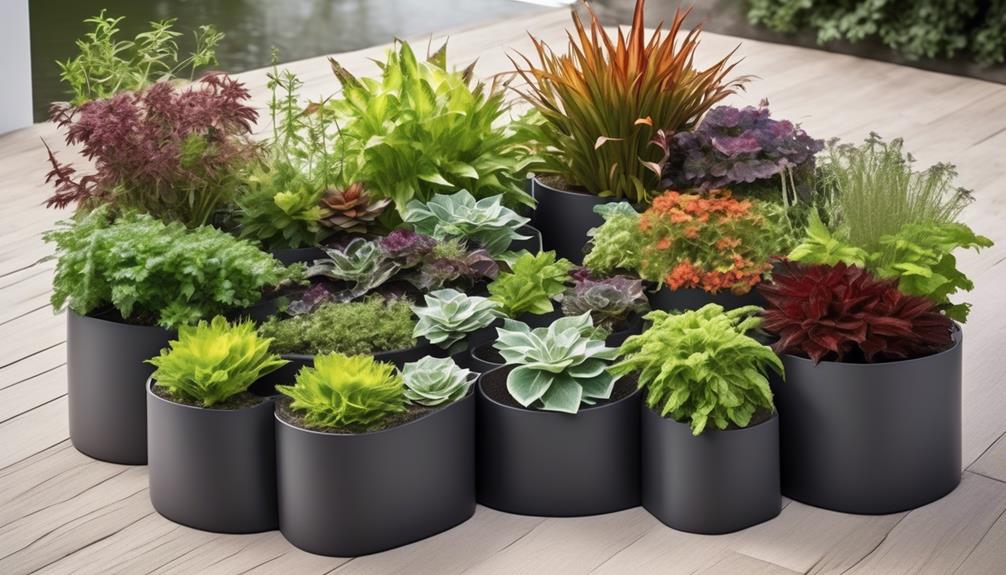
Have you ever wondered about the various types of self-watering systems available for planters and their specific mechanisms for efficient water delivery to plants? When it comes to plant hydration and soil moisture management, there are several innovative self-watering techniques and irrigation methods that can be employed. Below, we will delve into four common types of self-watering systems and their unique mechanisms for ensuring optimal moisture levels for plants.
| Type of Self-Watering System | Mechanism |
|---|---|
| Wick System | Utilizes a wick to draw water from a reservoir into the soil, maintaining consistent moisture levels. |
| Passive System | Relies on the principle of capillary action to deliver water from a reservoir to the soil as needed by the plant. |
| Sub-Irrigation System | Involves a reservoir located beneath the soil, allowing plants to absorb water through the bottom up, preventing overwatering. |
| Self-Regulating System | Uses a water level indicator to gauge soil moisture and release water from the reservoir only when necessary, preventing waterlogging. |
These self-watering systems offer efficient and reliable ways to maintain soil moisture and ensure proper plant hydration, making them valuable tools for plant care enthusiasts.
Choosing the Right Planter Size
Choosing the right planter size is crucial for ensuring the adequate space and soil volume necessary to support healthy plant growth and development. When choosing a planter, it's important to consider the plant's mature size and root system. A planter that's too small can restrict root growth, leading to stunted plants, while a planter that's too large can hold excess water, causing root rot.
The pot size directly impacts the watering needs of the plant. A larger pot will hold more soil, which can retain more water, requiring less frequent watering. However, proper drainage is essential regardless of the planter size. Inadequate drainage can lead to waterlogged soil, depriving the roots of oxygen and causing root rot.
Before selecting a planter, it's essential to assess the plant's watering needs, growth habits, and mature size. By choosing a planter with the appropriate size and good drainage, we can provide the optimal environment for plants to thrive. It's also important to consider the material of the planter, as materials like terracotta and unglazed ceramic can allow for better aeration of the roots, while plastic and metal may retain more moisture.
Best Plants for Self-Watering Planters
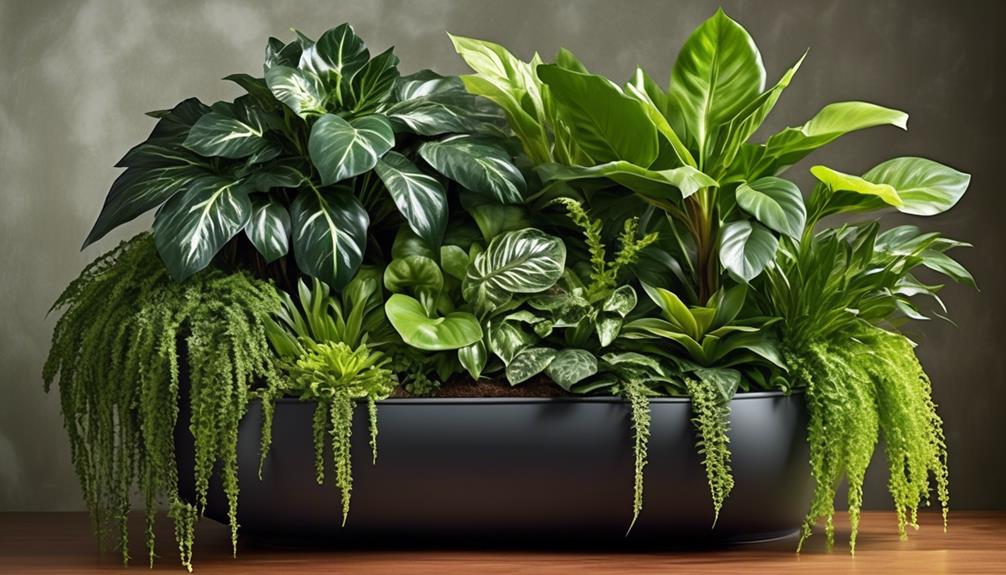
When selecting plants for self-watering planters, we need to consider ideal choices that thrive in consistent moisture levels. Understanding the watering frequency required by different plant species is essential for successful growth and maintenance.
Ideal Plant Choices
Popular choices for self-watering planters include low-maintenance plants such as snake plants, pothos, and peace lilies, which thrive in consistent moisture levels. When considering plant selection for self-watering planters, it's crucial to choose species that can tolerate moist conditions without succumbing to root rot. Plants with moderate to low watering needs are ideal for self-watering containers. These include spider plants, Chinese evergreens, and philodendrons. Their ability to adapt to the self-watering system ensures healthy growth while minimizing the risk of overwatering.
Additionally, herbs like mint, basil, and cilantro can flourish in self-watering planters, providing a fresh supply for culinary use. When utilizing self-watering techniques, selecting plants with similar water requirements is essential to maintain a harmonious environment within the planter.
Watering Frequency Tips
In self-watering planters, selecting plants with similar water requirements is essential to maintain a harmonious environment within the planter, ensuring optimal growth and minimizing the risk of overwatering.
When considering watering frequency, it's crucial to account for factors such as plant species, planter size, and environmental conditions. Some plants, like succulents and cacti, thrive in drier conditions and may only require watering every 1-2 weeks, while others, such as ferns and peace lilies, prefer consistently moist soil and may need watering every 3-4 days.
Monitoring moisture levels is imperative for successful plant growth. Self-watering planters enable precise moisture control, promoting plant health by ensuring that the soil moisture remains within the ideal range for the selected plant species, reducing the likelihood of both under and overwatering, and ultimately fostering optimal growth.
Growth and Maintenance
Selecting plant species with compatible water requirements is crucial for successful growth and maintenance in self-watering planters. Proper selection ensures that the plants receive the right amount of water, promoting healthy growth and minimizing maintenance. When choosing plants for self-watering planters, it's essential to consider their specific watering needs to achieve optimal results. Below is a table featuring some of the best plants for self-watering planters, along with their water requirements and growth characteristics.
| Plant | Water Requirements | Growth Characteristics |
|---|---|---|
| Snake Plant | Low | Slow-growing |
| Peace Lily | Moderate | Air-purifying |
| Spider Plant | Moderate | Fast-growing |
| Pothos | High | Trailing vines |
These plants are well-suited for self-watering planters and can thrive with the appropriate watering techniques, contributing to an aesthetically pleasing and low-maintenance indoor environment.
Maintenance and Care Tips
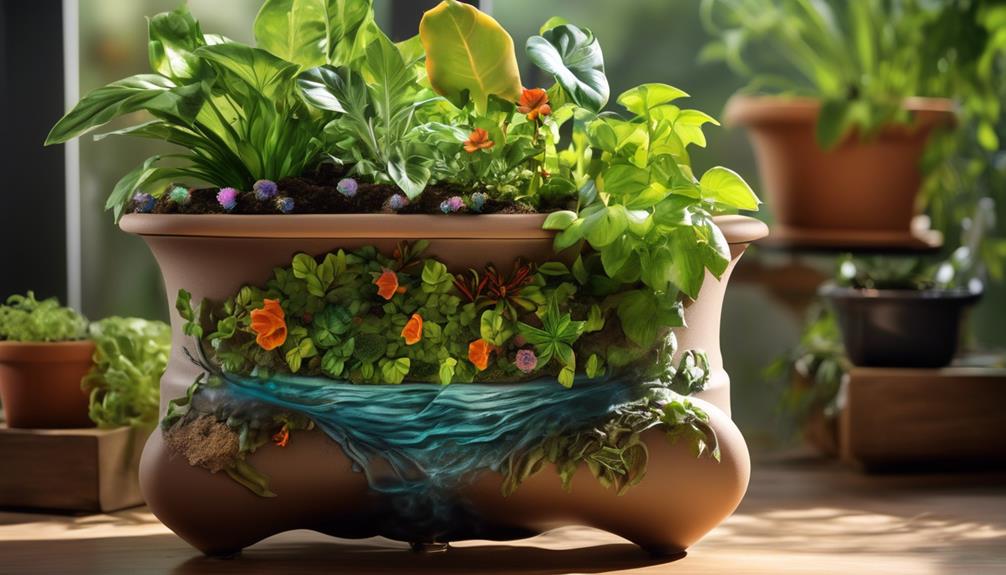
As we consider the maintenance and care of self-watering planters, it's essential to focus on water level monitoring and soil and nutrient management.
By regularly monitoring the water level, we can ensure that the plants receive an adequate supply without risking overwatering.
Additionally, managing the soil and nutrient content is crucial for the overall health and growth of the plants in these innovative planters.
Water Level Monitoring
Monitoring the water level in self-watering planters is crucial for ensuring optimal plant health and growth. Watering efficiency is enhanced through technology integration, allowing for precise control over moisture levels.
Many self-watering planters feature innovative designs that incorporate water level indicators, such as transparent reservoirs or electronic sensors. These innovations provide real-time feedback, enabling users to adjust watering frequency and duration based on the plant's specific needs.
Regularly checking the water level ensures that the reservoir doesn't run dry, preventing stress and potential damage to the plants. Additionally, it helps to prevent overwatering, which can lead to root rot and other issues.
Soil and Nutrient Management
To ensure optimal growth and health of plants in self-watering planters, it's essential to carefully manage the soil and nutrients, taking into account factors such as moisture retention, aeration, and nutrient balance.
- Soil Moisture: Regularly check the moisture level in the soil to ensure it remains within the optimal range for the specific plant species. Adjust the watering frequency based on the moisture needs of the plants.
- Nutrient Absorption: Monitor the nutrient levels in the soil and replenish as needed to maintain a balanced nutrient profile. Consider using slow-release fertilizers or organic compost to provide a steady supply of nutrients for the plants.
- Aeration: Periodically aerate the soil to prevent compaction and facilitate nutrient absorption. This can be achieved through gentle stirring of the soil or using specialized aerating tools.
Environmental Impact Considerations
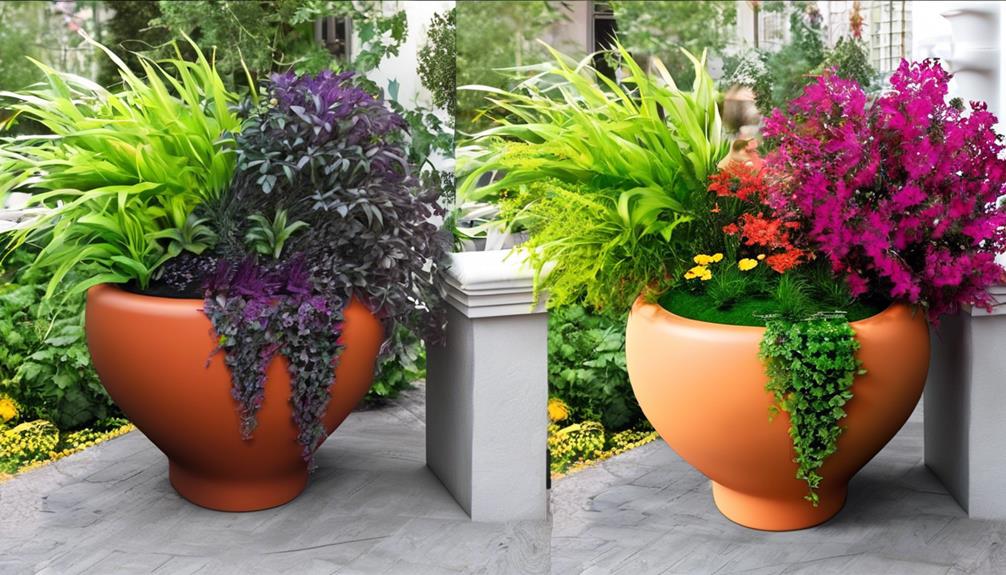
Considering the potential environmental impacts is crucial when evaluating the use of self-watering planters in various settings. One of the key advantages of self-watering planters is their contribution to environmental sustainability through efficient water conservation. These planters are designed to minimize water wastage by providing plants with a consistent water supply, reducing the overall water consumption compared to traditional watering methods. This has a significant impact on water conservation, particularly in regions facing water scarcity or during drought periods.
Moreover, the utilization of self-watering planters can positively influence plant growth and root development, which subsequently contributes to the environmental landscape. By ensuring plants receive adequate water at all times, these planters promote healthy root systems and overall plant vitality. This can have a cascading effect on the surrounding environment by enhancing green spaces, air quality, and biodiversity.
However, it's essential to consider the materials used in the construction of self-watering planters and their potential long-term environmental impact. Choosing eco-friendly, sustainable materials can further enhance the positive environmental footprint of these planters, ensuring that they align with broader environmental preservation goals.
Potential Drawbacks to Consider
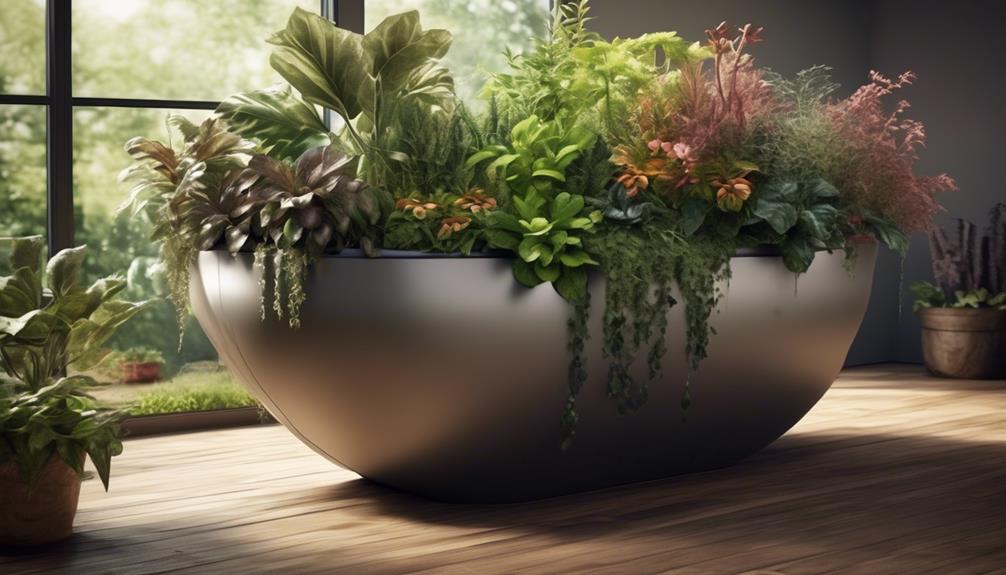
When considering self-watering planters, it's important to acknowledge the potential drawbacks that may arise.
Maintenance requirements such as cleaning and replacing the watering system components can add to the overall upkeep.
Additionally, the control of soil moisture may be challenging, potentially leading to overwatering or underwatering of the plants.
Furthermore, the impact of self-watering systems on plant health should be carefully monitored to ensure it aligns with the specific needs of the plant species.
Maintenance Requirements
We have found that regular cleaning of the watering system and periodic adjustment of the soil moisture levels are essential for optimal performance of self-watering planters. Proper maintenance is crucial for ensuring the health of plants and the longevity of the planter system.
Here are some key maintenance requirements to consider:
- Cleaning the watering system regularly to prevent clogs and ensure proper water distribution.
- Periodic adjustment of the soil moisture levels to accommodate changes in weather and plant growth.
- Checking and maintaining the overall structural integrity of the planter to prevent leaks or other malfunctions.
Soil Moisture Control
To ensure the optimal performance of self-watering planters, it's crucial to consider potential drawbacks associated with soil moisture control.
While self-watering planters offer enhanced watering efficiency and promote plant health, there are considerations regarding soil moisture and its impact on root development.
Overly moist soil can lead to root rot and other fungal diseases, jeopardizing the overall health of the plant. Additionally, if the self-watering system malfunctions, it may result in waterlogged soil, depriving the roots of essential oxygen and impeding their growth.
Monitoring and adjusting the watering system to suit the specific needs of different plants is essential to prevent these issues. Understanding the balance between soil moisture and root development is imperative for the successful implementation of self-watering planters.
Plant Health Impact
Monitoring the soil moisture levels and adjusting the watering system accordingly is essential to mitigate potential drawbacks and ensure the overall health of plants in self-watering planters. Impact on plant growth can occur if the watering system isn't properly calibrated.
Overwatering can lead to root rot and other water-related issues, while underwatering can stunt growth and cause wilting.
Additionally, the watering efficiency of self-watering planters may vary depending on factors such as plant type, environmental conditions, and planter design. It's crucial to closely observe the plants' response to the self-watering system and make adjustments as needed to optimize their health and growth.
DIY Self-Watering Planter Options
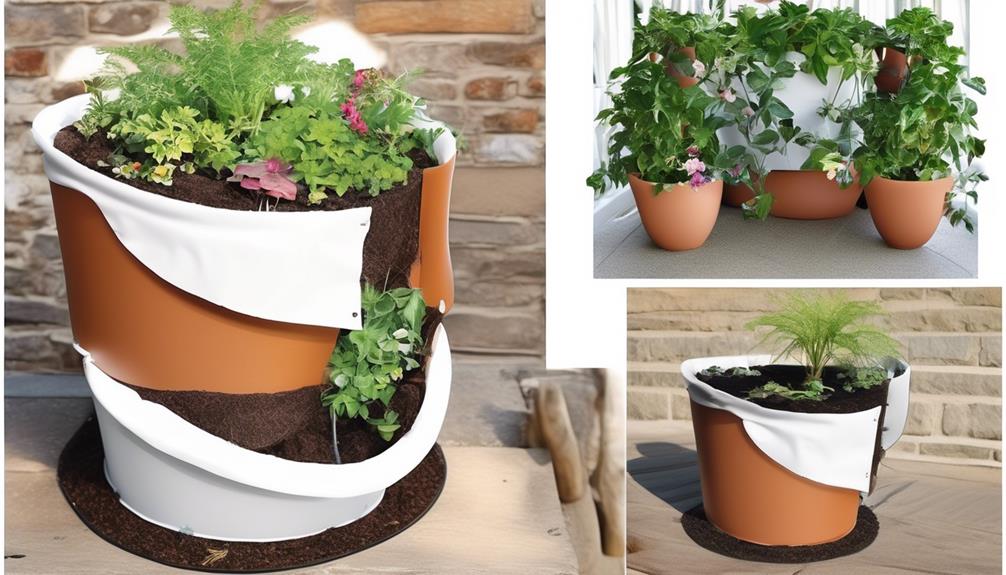
What are the most effective DIY self-watering planter options for maintaining optimal moisture levels in potted plants? DIY self-watering planters offer several benefits, including consistent moisture supply, reduced watering frequency, and improved plant health. Here are some popular DIY options for creating self-watering planters:
| DIY Option | Description |
|---|---|
| Wicking System | Utilizes a wick to draw water from a reservoir into the soil, ensuring a consistent moisture supply. |
| Upcycled Containers | Repurposes everyday items like plastic bottles or containers into self-watering planters, promoting sustainability. |
| Capillary Mat System | Involves a capillary mat that draws water from a reservoir into the soil through capillary action, maintaining optimal moisture levels. |
| Self-Watering Trays | Features a water reservoir beneath the plant container, allowing the soil to draw up water as needed, promoting efficient water usage. |
Each DIY option offers unique advantages, and the choice depends on factors such as plant type, container size, and personal preference. When selecting a DIY self-watering planter option, it's essential to consider the specific watering requirements of the plants and the environmental conditions to maintain optimal moisture levels for healthy plant growth.
Comparing Self-Watering Vs. Traditional Planters
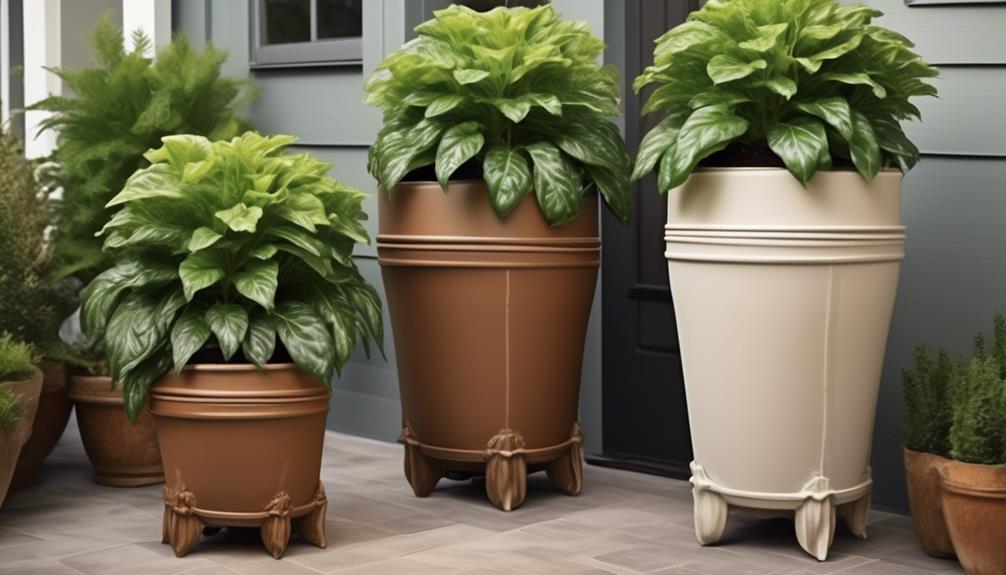
Comparing self-watering planters with traditional planters provides valuable insights into the efficiency of moisture retention and its impact on plant health and growth. When evaluating the two types of planters, several factors come into play, including cost, environmental impact, efficiency, and plant health impact.
- Comparing cost: Traditional planters often require more frequent watering, leading to increased water consumption and potentially higher water bills. On the other hand, self-watering planters may initially cost more but can result in long-term savings due to their water-saving capabilities.
- Environmental impact: Self-watering planters have the potential to reduce water usage, making them more environmentally friendly compared to traditional planters. This efficient use of water is beneficial for areas experiencing water scarcity or drought conditions.
- Efficiency, plant health impact: Self-watering planters can provide a more consistent moisture level for plants, which is essential for their overall health and growth. Traditional planters, depending on the watering habits of the gardener, may result in fluctuating moisture levels, impacting the well-being of the plants.
Tips for Maximizing Planter Performance
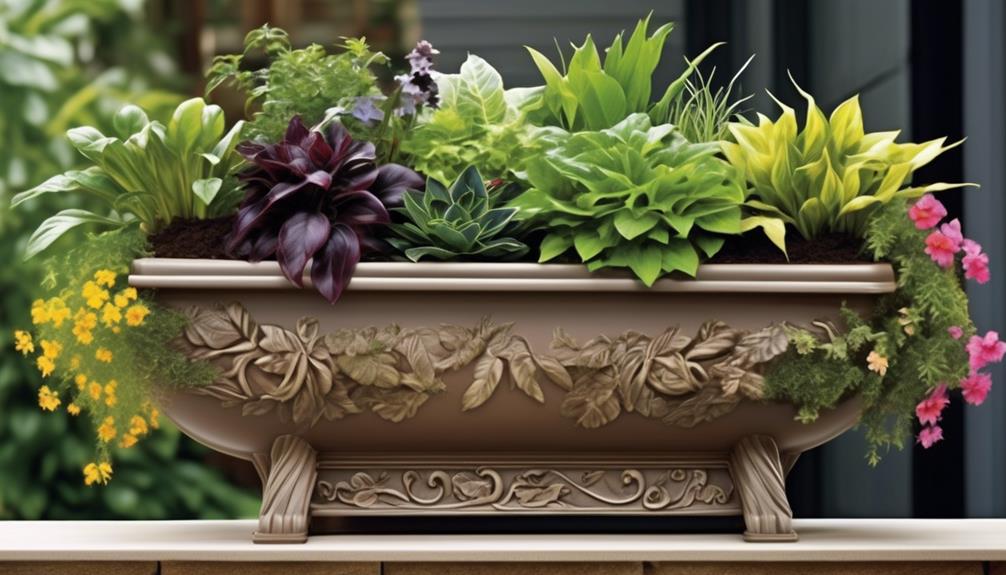
To enhance planter performance, consider implementing a consistent watering schedule to maintain optimal moisture levels for plant growth. Consistency is crucial for maximizing root growth and overall plant health. It's essential to adjust the watering schedule based on factors such as plant type, season, and environmental conditions.
When plants are actively growing or during hot weather, they may require more frequent watering to support their increased metabolic needs. Conversely, in cooler months or during dormancy, reducing the frequency of watering can prevent waterlogging and root rot.
Monitoring the moisture level of the soil is also vital. Using a soil moisture meter can help determine when it's time to water, ensuring that the plants receive adequate water without becoming waterlogged.
Additionally, it's beneficial to incorporate occasional deep watering sessions to encourage deep root growth, as shallow roots can make plants more susceptible to drought stress.
Frequently Asked Questions
Can Self-Watering Planters Be Used for Outdoor Gardening?
Yes, self-watering planters can be used for outdoor gardening. They provide outdoor durability and water efficiency, making them a great option for maintaining plants in outdoor settings.
These planters can accommodate various plant sizes and come in a range of container aesthetics to complement outdoor spaces.
Their self-watering feature ensures consistent moisture levels, reducing the need for frequent watering and allowing for optimal plant growth in outdoor environments.
What Are the Potential Long-Term Cost Savings of Using Self-Watering Planters?
Incorporating self-watering planters can result in potential long-term cost savings due to reduced water usage. These planters offer environmental benefits by promoting water conservation through efficient irrigation systems.
Over time, the reduced water consumption can lead to financial savings and contribute to sustainable gardening practices. The initial investment in self-watering planters can yield significant returns through decreased water bills and minimized environmental impact.
Are There Any Specific Soil or Fertilizer Requirements for Self-Watering Planters?
In self-watering planters, soil quality is vital for optimal plant growth. Good soil should be well-draining yet retain moisture, such as a mix of peat, vermiculite, and perlite.
Fertilizer type is also important; slow-release granular fertilizers work well, delivering nutrients gradually. Avoid liquid fertilizers, as they can lead to over-fertilization and damage the plants.
Understanding the specific soil and fertilizer requirements ensures healthy and thriving plants in self-watering planters.
How Do Self-Watering Planters Impact the Growth and Health of Plants Compared to Traditional Planters?
When comparing self-watering planters to traditional ones, the impact on plant growth is notable. The consistent and efficient watering system in self-watering planters promotes healthier root development and improved hydration, leading to better overall plant health.
This method also reduces the risk of over or under-watering, providing a more stable environment for plant growth.
Can Self-Watering Planters Be Used for Larger Plants or Trees, or Are They Better Suited for Smaller Plants?
When considering larger plants or trees, self-watering planters are suitable for outdoor gardening. They provide consistent moisture, promoting healthy growth while reducing soil and fertilizer requirements.
Long term, they offer cost savings. Comparing growth in self-watering planters to traditional ones shows improved plant health.
Their efficient water delivery system supports tree growth, making them a viable option for larger plants, contributing to overall garden vitality.
What Are the Benefits of Using Self-Watering Planters?
Self-watering planters effectiveness is proven in their ability to regulate water supply to plants, preventing over or under-watering. This results in healthier and more vibrant plants. Additionally, these planters save time and effort by reducing the frequency of watering needed, making them an ideal choice for busy individuals.
Conclusion
In conclusion, self-watering planters offer numerous benefits for plant health and convenience. The allusion of a well-oiled machine comes to mind when considering the efficient and consistent watering provided by these systems.
With the right maintenance and plant selection, self-watering planters can be a game-changer for any gardener, providing a reliable and hassle-free way to keep plants thriving.

